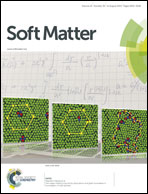Electrolytes based on alkoxysilyl-functionalized ionic liquids: viscoelastic properties and conductivity
Abstract
Ionic liquids can be successfully used as electrolytes in electrochemical devices when they are in their quasi-solid state. Among several methods of solidification, a sol–gel process was chosen and a set of alkoxysilyl-functionalized iodide imidazolium-based ionic liquids were synthesized. The electrolytes were prepared by mixing these ionic liquids with a non-polymerisable ionic liquid (1-methyl-3-propylimidazolium iodide (MPIm+I−)). Iodine was dissolved in an electrolyte matrix in order to form an I3−/I− redox couple. The change of the structure from sol to gel was followed by rheological tests in order to show the effect of different rheological parameters on the gelation process. The solvolysis with glacial acetic acid and condensation were followed by rheological experiments on the samples taken from a batch, and in situ on the rheometer. The formed three-dimensional sol–gel networks of various alkoxysilyl-functionalized ionic liquids differed in their microstructures and viscoelastic properties that were correlated with conductivity. The results show that the conductivity of approximately 10−3 S cm−1 at room temperature was achieved for the gels with relatively high values of elastic modulus and noticeable viscous contribution. It is shown that not only the viscosity but also the viscoelastic behavior and especially the relationship between viscous and elastic moduli (phase shift) together with the time of gelation are essential for the high conductivity of electrolytes.


 Please wait while we load your content...
Please wait while we load your content...